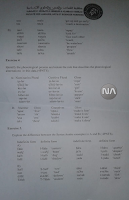Phonology resit exam answers about: Trubetzkoy’s phonological oppositions, distinctive features, vowel deletion, vowel harmony, consonant Insertion, Syrian Arabic, coronal sounds and phonological rules.
Exercise 1
Complementary distribution: The occurrence of sounds in a language that they are never occurs in the same phonetic environment. Sounds that are in complementary distribution are allophones of the same phoneme. consider the sounds [p] and [pʰ] in these examples :
spat [spæt]
spool [spul]
pool [pʰul]
peek [pʰik]
You see that the sound [ph] only occurs word-initially but never after [s] unlike [p].spool [spul]
pool [pʰul]
peek [pʰik]
Equipollent oppositions: is formed by a contrastive pair or group of members which are differentiated by different positive features.
e.g. the phonemes /t/ and /k/ form an equipollent opposition in which the voiceless consonant /k/ is velar while the voiceless consonant /t/ is alveolar.
Exercise 2
| /ṛ/ | /ṣ/ | /l/ | /i/ | /ö/ | / œ/ | /py/ | / ʔ / | |
Consonantal
|
+
|
+
|
+
|
-
|
-
|
-
|
+
|
-
|
Syllabic
|
+
|
+
|
-
|
+
|
+
|
+
|
-
|
-
|
Sonorant
|
+
|
+
|
+
|
+
|
+
|
+
|
-
|
-
|
Continuant
|
+
|
+
|
+
|
-
|
-
|
|||
Del R
|
-
|
|||||||
Nasal
|
+
|
+
|
-
|
-
|
||||
Lateral
|
-
|
+ |
-
|
|||||
Anterior
|
+
|
+
|
+
|
+
|
-
|
|||
Coronal
|
+
|
+
|
+
|
-
|
-
|
|||
Back
|
-
|
-
|
-
|
-
|
-
|
-
|
-
|
-
|
Round
|
-
|
-
|
-
|
+
|
+
|
-
|
-
|
|
High
|
-
|
-
|
+
|
+
|
-
|
-
|
+
|
-
|
Low
|
-
|
-
|
-
|
-
|
-
|
+
|
-
|
-
|
Tense
|
-
|
+
|
-
|
+
|
+
|
-
|
+
|
-
|
Exercise 3
If we consider the data (A), to form the perfective form of the verb we add a siffix -ia at the end of this verb as in :
olo oloia
aŋa a ŋia
usu usuia
However, by following the same process the results for the data (B) should be like:aŋa a ŋia
usu usuia
taui tauiia
naumati naumatiia
But, it is not the case in this data. We have :naumati naumatiia
taui tauia
naumati naumatia
So, an /i/ sound is deleted. The one of the verb root which undergoes this change or the one of the suffix. To solve this, let’s take other examples from this language :naumati naumatia
tafe tafea
taʔe taʔea
We conclude then that the /i/ of the suffix which is deleted. Accordingly, by observing carefully the data (A) and (B), we notice that in all these examples, the suffix -ia is preceded by the vowel sounds /u/, /o/, /a/, /e/ and /i/. These sounds could be classified in two categories back (/u/, /a/, /o/) and front (/i/, /e/) vowels.taʔe taʔea
As a conclusion, the /i/ of the suffix is deleted only when it is preceded by a front vowel sound.
Exercise 4
A- Vowel harmony, a high vowel of a suffix agrees in backness with the stem vowel.
B- Consonant Insertion to break up a vowel cluster.
Exercice 5
In Syrian Arabic, to form the definite form of nouns we add the prefix /l/ at the initial of the words like in data (A). However, in data (B) we notice that the initial consonant is doubled as in :
Saff S-Saff
taxt t-taxt
The reason underlying this phonological change consists on the consonant following the prefix. In fact, when the prefix precedes a noncoronal consonant it remains unchanged; whereas, it precedes a coronal consonant it assimilates to this coronal consonant.taxt t-taxt













1 Comments
I'll start my exams next week ... wish me good luck
ReplyDelete